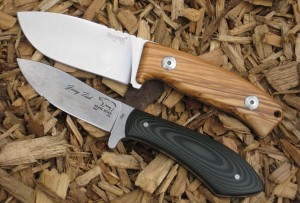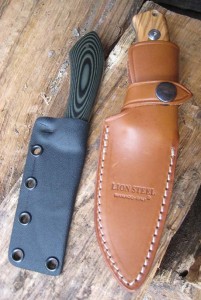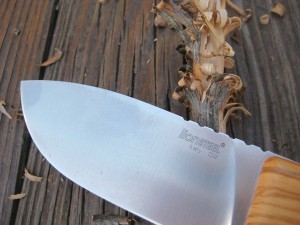by John Markwell | Contributing Editor

Although the blade designs are quite different, both the Lion Steel M2 (top) and the White River Sendero Pack (bottom) are very capable outdoor knives. The tested M2’s scales are olive wood while the Sendero Pack’s are G10.
Rambling around the SHOT show we normally give the many knife displays just a casual glance, and then move along, as we need more knives like another hole in our head. 2015 was different in that two knives in particular caught our eye. One was from an Italian maker, Lion Steel, and the other was made in the USA by White River Knives. We liked these so much that both are now here in the Alleghenies. We thought TheGunMag.com readers might find they would make good gifts for that someone or, yourself.
We had been contemplating adding a stout fixed blade to the GHB (get home bag) that travels in our truck but most of the knives we’d considered were just too big, heavy or both. What we felt we needed was a medium sized blade for general field use; not what some would consider a full blown “survival” knife but a “sort of” survival knife. The short story is that we wandered by the small Lion Steel display and the M2 model immediately caught our eye. Lion Steel (online: lionsteel.it) was founded in 1969 in Maniago, Italy, by Gino Pauletta and today crafts knives under the direction of his sons.
TheM2 was designed in collaboration with the now defunct Italian knife forum MCFK as a medium duty field/hunting knife. The deep bellied blade of the M2 is made from D2 stainless steel, is 3.54 inches in length and measures 1.31” from spine to edge; it’s a wide blade. The drop point blade is flat ground and is a good slicer despite its .15” thickness. The M2’s blade is satin finished and the olive wood scales (G2 scales are also available) are attached to the full tang with stout stainless Torx T8 screws. The 4.3” handle has a lanyard hole and is very comfortable in the hand with a distinct lack of abrasive edges and corners. The overall length of the M2 is a just 7.68”. It weighs just barely over 8 ozs. and it comes with a good leather belt sheath.
Our sample M2 from Lion Steel has been put through its paces here in the Alleghenies tackling everything from food preparation in the kitchen to fire building up at the cabin/campsite and other assorted cutting chores. Before using the M2, we touched up the factory edge on a ceramic sharpener. We cut both meats and vegetables with the M2; it slices and chops with aplomb. The edge of the D2 steel held up quite well after use on both wooden and polymer cutting boards; usually a good test of edge holding ability. We whittled out a couple of fuzz sticks for fire starting as well a splitting some kindling and then we cut some rubber mine belting and fire hose for hanging steel targets. Throughout this, the knife was comfortable to use and the edge held up well enough to go back into the kitchen for some more food processing without an edge touch-up. We think the Lion Steel M2 will be the perfect addition to our GHB and it should be capable of handling any reasonable task asked of it, should the need arise. The M2 is available online from several vendors with retail prices ranging from $115 to $130. If you are looking for a good universal field knife at a reasonable price the M2 is certainly worth a look.
Considering the fact that there are thousands of knives on display at SHOT we found it pretty amazing that we were really drawn to a second one.
The Sendero Pack Knife, from White River Knives (online: whiteriverknives.com) is a Jerry Fisk design that is a scaled down version of Jerry’s Sendero Bush Knife. Just 10% smaller, the Sendero Pack was designed for folks with hands slightly smaller than Jerry’s. We talked to Jerry at the White River booth about the Sendero Pack and got a good rundown on the design details of the knife. The deeply curved blade is of a semi-drop point design and is made from CPM S30V steel with a hardness of 59/60 HRC. The elegantly curved spine of the relatively thin blade has the edges beveled to enhance its slicing capabilities. The 3.25” blade length is more than enough to handle any game processing chores in the lower 48 and the edge curve should be ideal for skinning. We found the blade shape of the Sendero Pack knife reminiscent of the Nessmuk knife popularized by George Washington Sears in his book Woodcraft which was published in 1884. Nessmuks have a world-wide cult following and are produced by several custom makers. (Google Nessmuk Knife for more info.)

Both the Lion Steel M2 (right) and the White River Sendero Pack (left) come with good, functional sheaths; a rarity in this day and age.
During our chat with Jerry, he explained the subtleties of the handle and we were impressed with the thought that went into its design. The smooth G10 scales (attached with two rivets) felt extremely good in the hand. This was a knife with a handle designed to be used for extended periods of time; it was smooth and ergonomic. Even when flipped over for upside down use, the handle fit our hand well and seemed like it would allow for good control and application of power to the cutting edge.
We were surprised when we got our sample Sendero Pack in the mail from John Cammenga at White River Knives.The Sendero Pack knives are serialized and the one we received was #003. John told us via Email that the blade was slightly blemished and that they thought about destroying it and building another #003 but decided to just send it to us for testing. The slight blemish on the blade is almost undetectable and certainly does not have any affect on the function or strength of the blade. The overall length of the Sendero Pack knife is just 7.45” and the weight, including the slim Kydex sheath, is a mere 4.9ozs. making it eminently haulable.
We wish we could report on using the new White River Sendero Pack Knife in the game fields but getting a sample in February doesn’t allow for that, this year. We did however use the Sendero Pack for more mundane tasks. Around most camps, we’d bet more food is processed with hunting knives than big game and, like the M2, we first took the Pack to the kitchen where we used it for about two weeks dealing with both meats and vegetables. The thin blade of the Sendero Pack was great for slicing meats and chopping veggies. Boning out a ham and trimming up a brisket for smoking was as close as we got to major meat processing but we can tell from this limited use on meat that the Sendero Pack will shine in the field. We never touched the edge for the entire time we used the Pack in the kitchen. After an edge touch up, we took to cutting more mine belt and fire hose for target building. The thin blade again shined here, especially in dealing with the mine belt, which is one tough material to cut.
We are going to stuff the Sendero Pack Knife in our kit bag and haul it West for our summer varmint hunting sojourn. Using it for a month or more as a camp/field knife should give us an even better appreciation of the Pack’s capabilities. I doubt we will have to take advantage of White River’s no questions asked/no paperwork lifetime warranty as the Pack seems to be just about indestructible. And, since our father taught us how to put an edge on a knife, we probably will not need their sharpening service either (customer pays the shipping only). Following our summer trip, we are going to stick our #003 Sendero Pack Knife in the top flap of our hunting pack in anticipation of the fall hunting seasons.
As this is written, Sendero Pack knives are just starting to be shipped to White River dealers and are not yet even listed on the company’s website. If one is in the market for a small lightweight, high quality camp/hunting knife that is comfortable to use we’d suggest looking at the Sendero Pack from White River Knives. Retailing for $200, we consider the Pack to be a good bargain in today’s knife market. Good cutting.




